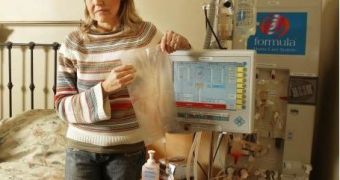A team of Canadian researchers discovered that a drug used to treat dialysis catheter malfunction in kidney dialysis patients is also very effective at preventing blood stream infections.
Dr. Brenda Hemmelgarn from the University of Calgary Faculty of Medicine and her colleague Dr. Nairne Scott-Douglas, both members of the Libin Cardiovascular Institute of Alberta, carried out a randomized trial at 11 sites across Canada.
The study included 225 hemodialysis patients, out of whom 115 were administered the normal catheter locking solution of heparin (anticoagulant) after each dialysis session, and 110 received rt-PA (Recombinant Tissue Plasminogen Activator – a protein involved in the breakdown of blood clots) once a week.
The results showed that patients receiving only heparin, faced twice the risks of suffering from a catheter malfunction, and a three-fold risk of blood stream infections.
Hemmelgarn said that “we now have evidence that we can prevent these complications using rt-PA, with a goal to ultimately improve outcomes for patients with kidney failure.”
People who suffer from kidney failure usually undergo hemodialysis, which is a treatment used to clean their blood.
For the hemodialysis procedure, a catheter placed into the blood system is usually necessary, but the problem is that complications can appear.
The most common are 'catheter malfunction', involving blood clots forming at the tip of the catheter, and infections in the blood stream.
To prevent any catheter malfunction and keep it working for a long period of time, heparin is used as a locking solution in the catheter after dialysis.
Didja Nawolsky knows the importance of avoiding infection, since she has been on dialysis ever since 2003, when her kidneys failed.
So far, she has had 15 permanent and temporary catheters, and her everyday concern is to avoid any kind of infections.
“An infection can easily get into my blood stream and cause serious problems,” she says.
“The line also has to be removed and replaced when there is an infection, which is a rather unpleasant experience I prefer to avoid.
“This research will benefit myself and others using catheters because it reduces infections, which is hugely important.”
Scott-Douglas added that “given the considerable cost of blood infections and catheter malfunction physicians should consider using r-TPA prohylactically to prevent these complications in higher risk patients.”
These findings are published in the January 26th edition of the New England Journal of Medicine.
For more information about kidney disease and how you can help, go to www.kidneymarch.ca

 14 DAY TRIAL //
14 DAY TRIAL //